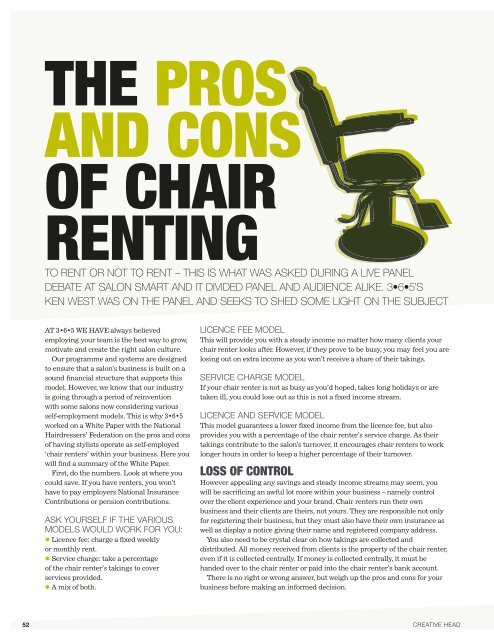Creative HEAD May 2017
Create successful ePaper yourself
Turn your PDF publications into a flip-book with our unique Google optimized e-Paper software.
THE PROS<br />
AND CONS<br />
OF CHAIR<br />
RENTING<br />
TO RENT OR NOT TO RENT – THIS IS WHAT WAS ASKED DURING A LIVE PANEL<br />
DEBATE AT SALON SMART AND IT DIVIDED PANEL AND AUDIENCE ALIKE. 3•6•5’S<br />
KEN WEST WAS ON THE PANEL AND SEEKS TO SHED SOME LIGHT ON THE SUBJECT<br />
AT 3•6•5 WE HAVE always believed<br />
employing your team is the best way to grow,<br />
motivate and create the right salon culture.<br />
Our programme and systems are designed<br />
to ensure that a salon’s business is built on a<br />
sound financial structure that supports this<br />
model. However, we know that our industry<br />
is going through a period of reinvention<br />
with some salons now considering various<br />
self-employment models. This is why 3•6•5<br />
worked on a White Paper with the National<br />
Hairdressers’ Federation on the pros and cons<br />
of having stylists operate as self-employed<br />
‘chair renters’ within your business. Here you<br />
will find a summary of the White Paper.<br />
First, do the numbers. Look at where you<br />
could save. If you have renters, you won’t<br />
have to pay employers National Insurance<br />
Contributions or pension contributions.<br />
ASK YOURSELF IF THE VARIOUS<br />
MODELS WOULD WORK FOR YOU:<br />
• Licence fee: charge a fixed weekly<br />
or monthly rent.<br />
• Service charge: take a percentage<br />
of the chair renter’s takings to cover<br />
services provided.<br />
• A mix of both.<br />
LICENCE FEE MODEL<br />
This will provide you with a steady income no matter how many clients your<br />
chair renter looks after. However, if they prove to be busy, you may feel you are<br />
losing out on extra income as you won’t receive a share of their takings.<br />
SERVICE CHARGE MODEL<br />
If your chair renter is not as busy as you’d hoped, takes long holidays or are<br />
taken ill, you could lose out as this is not a fixed income stream.<br />
LICENCE AND SERVICE MODEL<br />
This model guarantees a lower fixed income from the licence fee, but also<br />
provides you with a percentage of the chair renter’s service charge. As their<br />
takings contribute to the salon’s turnover, it encourages chair renters to work<br />
longer hours in order to keep a higher percentage of their turnover.<br />
LOSS OF CONTROL<br />
However appealing any savings and steady income streams may seem, you<br />
will be sacrificing an awful lot more within your business – namely control<br />
over the client experience and your brand. Chair renters run their own<br />
business and their clients are theirs, not yours. They are responsible not only<br />
for registering their business, but they must also have their own insurance as<br />
well as display a notice giving their name and registered company address.<br />
You also need to be crystal clear on how takings are collected and<br />
distributed. All money received from clients is the property of the chair renter,<br />
even if it is collected centrally. If money is collected centrally, it must be<br />
handed over to the chair renter or paid into the chair renter’s bank account.<br />
There is no right or wrong answer, but weigh up the pros and cons for your<br />
business before making an informed decision.<br />
52<br />
CREATIVE <strong>HEAD</strong>


















